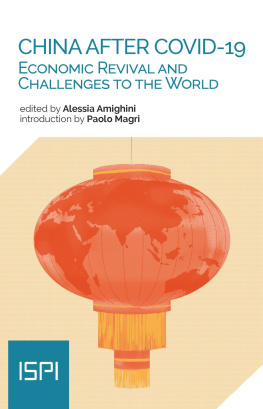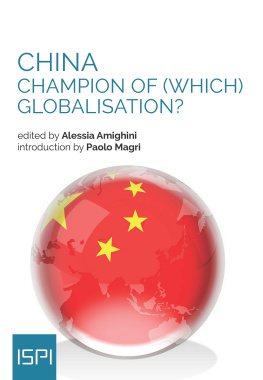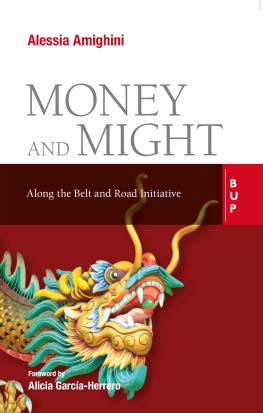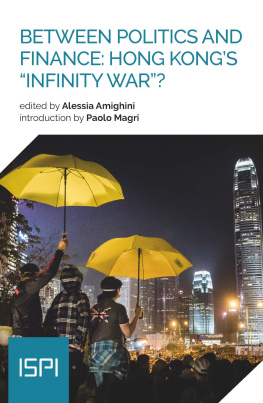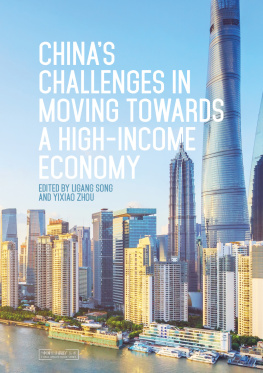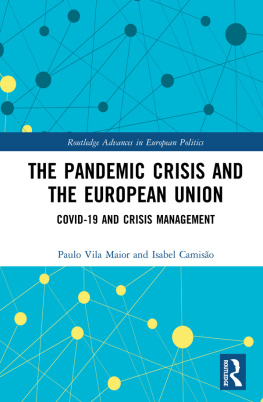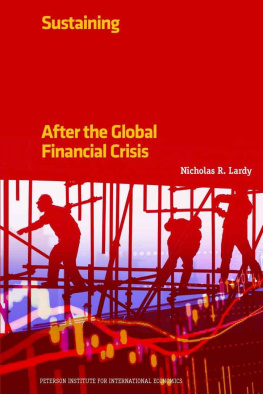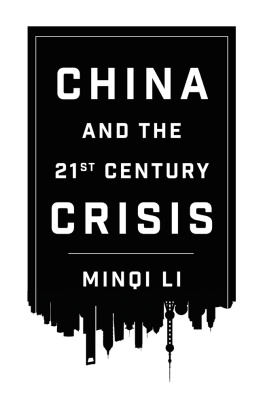2021 Ledizioni LediPublishing
Via Antonio Boselli, 10 20136 Milan Italy
www.ledizioni.it
China After Covid-19: Economic Revival and Challenges to the World
Edited by Alessia Amighini
First edition: July 2021
Image cover by Francesco Fadani
Print ISBN 9788855265225
ePub ISBN 9788855265232
Pdf ISBN 9788855265249
DOI 10.14672/55265225
ISPI. Via Clerici, 5
20121, Milan
www.ispionline.it
Catalogue and reprints information: www.ledizioni.it
This Report is realized with the support of the Policy Planning Unit of the Ministry of Foreign Affairs and International Cooperation pursuant to art. 23-bis of Presidential Decree 18/1967.
The opinions contained in this Report are solely those of the authors and do not necessarily reflect the opinions of the Ministry of Foreign Affairs and International Cooperation and ISPI.
Introduction
The coronavirus pandemic that has rocked China since December 2019 poses a gruelling test for the resilience of the countrys national economy. The premises were anything but positive for Beijing, which entered the crisis while already weakened by the profound effects of the trade war with the United States, a perilous internal rebalancing, and the need for financial deleveraging amid mounting domestic debt. The pandemic has further added to these challenges and, in 2020, Chinas GDP grew only by 2.3% one of the worst performances in history. However, once again this time, for China the past was prologue.
Over the past two decades, China has proven extremely successful in countering the effects of major crises, such as the 2007-08 financial crisis or the one that followed the 2002-03 SARS epidemic outbreak. Once again today, in spite of the rather weak performance in 2020, the economy is rapidly picking up pace with all three key economic indicators retail consumption, investments and trade recovering swiftly. If anything, there is talk of an overheating economy, with GDP growing by 18% year-on-year in the first quarter of 2021. In particular, the growth in retail consumption indicates that the leadership has been successful in rebuilding consumer confidence. Chinas approach to the global recession has been characterised by a significant degree of innovation pursued by the countrys lite, compared to the response in the aftermaths of the Global Financial Crisis.
Although Chinas economic system is radically different from that in Europe, the country remains an influential term of comparison in times of crisis, as regards the responses to the global decrease in demand and output recorded in 2020. Fiscal stimulus has been by far the most important policy to help the economy out of the crisis even though one should not forget that today China has relied on a more limited toolbox to restart the economy than it did after the Global Financial Crisis. Post-coronavirus China, in fact, has prioritised the domestic economy and recovery measures were not designed to support growth in the rest of the world as had been the case in the past. A key indicator in this sense is the framework of new investment projects, as China calls it: Chinese investments are now more selective, prioritising domestic consumption and the digitalisation of the national economy to the detriment of traditional large infrastructure projects. Moreover, Beijings willingness to innovate during the post-pandemic recovery was made clear by the monetary policy adopted by its leadership, which was clearly less aggressive than the approaches adopted by other countries and included very specific goals that focused on small and medium-sized enterprises i.e., the engine of the countrys labour market.
In light of the above, this Report examines how China designed and implemented its post-Covid recovery strategy, keeping an eye both on the internal and external criticalities the country had to overcome over the short and medium-term. In particular, the Report is articulated along two lines. Firstly, it focuses on Chinas domestic scenario, detailing the impact of the pandemic on the economic and political systems as well as on Chinas recovery policy choices. Secondly, it looks at the effects of the pandemic on the countrys international strategy, mainly focusing on the future of economic and trade relations with the United States and the prospects for the Belt and Road Initiative (BRI).
In the first chapter, Maximilian Krnfelt paints a composite picture of the effects the pandemic had on Chinas national economy. The author argues that, although the outlook for the countrys economic relaunch remains positive, China still runs substantial risks that might hinder its recovery, especially regarding the impact of a second wave of infections, the further contraction of foreign demand, and mounting financial difficulties. Nonetheless, in chapter 2, Haihong Gao contends China has benefited extensively from previous experiences in handling the risks that emerged from previous health crises (above all the SARS epidemic outbreak), when designing an anti-coronavirus health and economic response strategy. Gao makes the case for the countrys ability to learn from past mistakes, devoting special attention to debt sustainability, which was one of the main issues emerging from the measures China adopted in the aftermath of the global financial crisis.
Elisa Sales, in contrast, highlights in chapter 3 that rapidly developing consumer needs stimulated Chinas development of digital technologies in an effort to combat the health and economic crises. Although positive results were achieved, Sales argues there are still challenges that the pandemic has exacerbated and that the country is still finding hard to solve, mainly related to the inter-generational digital gap and access inequalities between rural and urban areas.
In chapter 4, Giulia Sciorati contextualises the traditional concept of pragmatic performance legitimacy within the anti-coronavirus policy choices made by the countrys political lite, contending that delivering and/or communicating a convincing anti-Covid-19 performance remained central in the leaderships attempts to counter the legitimacy challenges posed by the health and economic crises for the countrys political system.
In chapter 5, Eduardo Missoni opens the debate on the future of the BRI after the pandemic, stressing the role the Health Silk Road will play in the short-run to drive the entire initiative. The key takeaway from Missonis argument is the international community should jointly rethink the concept of health diplomacy and make sure peoples health replaces access to healthcare among the priorities of public policies worldwide.
In chapter 6, Yukon Huang investigates the future of China-US relations after the crisis. Huang suggests that, to the extent that China has been labelled a partner, competitor and rival at the same time, the United States should realise that the most controversial issues with China (e.g., reform of the WTO, data rights and economic and trade relations) should be tackled within multilateral frameworks like the G20, not bilaterally.

